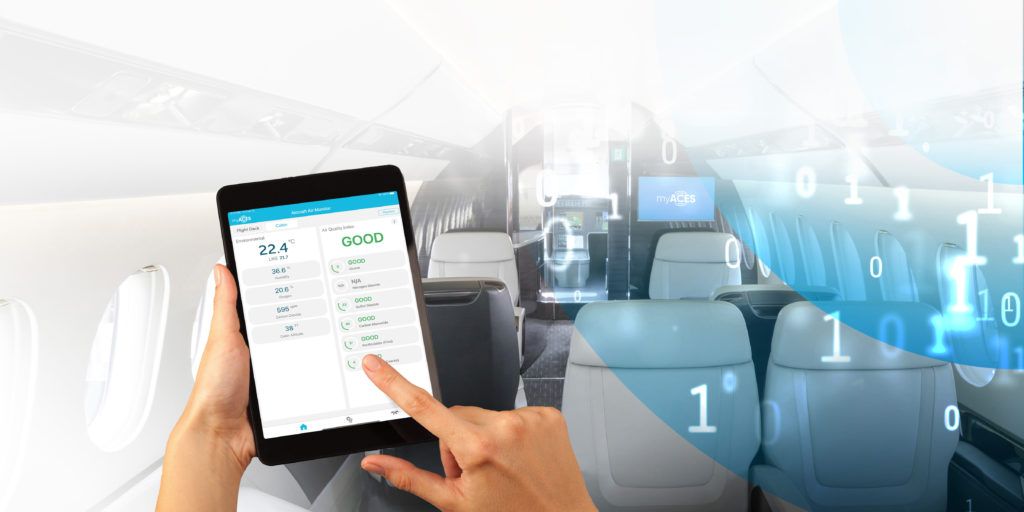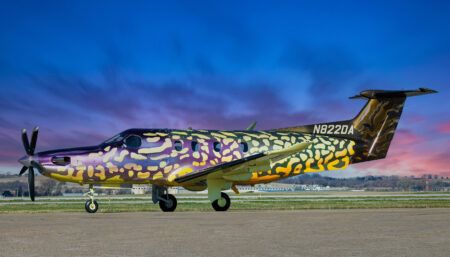Cabin air specialists share their developments for private aircraft interiors
Real-time air monitoring
Using sensor technology, Teledyne’s ACES is a certified, cabin environment monitoring system that checks onboard air quality in real time. The solution has garnered a prestigious Crystal Cabin Award in the Health & Safety category. The international award recognises aircraft interior innovations.
The Teledyne ACES system includes onboard devices designed for easy installation in the cabin and flight deck. These sense and monitor the air quality continuously as soon as the aircraft is powered, with no action required from the crew. The devices employ laboratory-grade sensors that record key environmental parameters, including temperature, humidity, carbon dioxide, carbon monoxide, ozone, volatile organic compounds and more.
The data recorded by the onboard units is transmitted automatically during flight and can be viewed in real time on a mobile device, via the myACES mobile app. The data is also transferred to an online cloud service portal for further processing and analysis. Maintenance and engineering teams can access this securely and use this more comprehensive data to better troubleshoot and diagnose events. It can also be used for trend monitoring, to identify potential emerging issues and help prevent future incidents.
…..
Reducing shared air
Designed by Teague and manufactured by Pexco Aerospace, AirShield is a retrofit solution that fits over the existing passenger air vents above every seat. It weighs less than 1 lb (0.45kg).
“Working with existing HEPA filtration systems, AirShield reduces shared air by at least 76% (in a full narrowbody cabin with no face masks) and increases the speed at which contaminated particles are expelled and replaced by freshly purified air by 230%,” says Anthony Harcup, senior director of airline experience at Teague.
AirShield has been engineered to be simple to manufacture and quick to install. It has a three-piece clip-together assembly. Teague shares that each installation takes less than a minute and an entire aircraft can be completed during standard overnight aircraft maintenance. “The design also benefits airlines who lease aircraft as they can remove AirShield equally as quickly, with no modifications needed to the aircraft to return it to its original state,” says Harcup.
As an additional layer of hygiene protection, Pexco also uses an antimicrobial additive to manufacture AirShield. This, the company claims, destroys 99.99% of bacteria (even antibiotic-resistant strains such as MRSA, VRE and CRE) upon contact – supporting airlines and OEMs to maintain high standards of hygiene on board.
To maximise the design and performance of AirShield, more than 60 million data points of computational fluid dynamics were used to assess cabin airflow independently. This included undertaking on-wing tests in collaboration with major airlines and aircraft lessors, including American Airlines, Southwest Airlines,
Alaska Airlines and Avolon. AirShield was a finalist in the 2023 Crystal Cabin Awards.
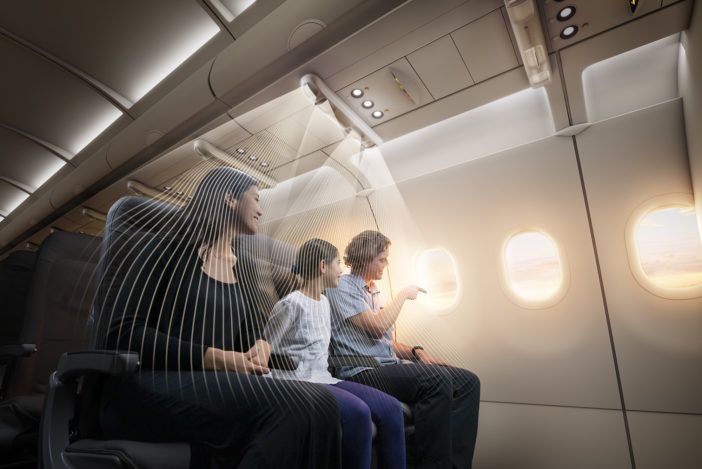
…..
Deodorising solution
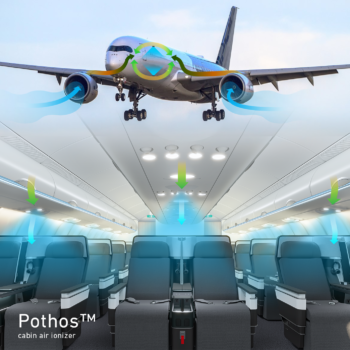
The Collins Pothos cabin air ioniser seeks to deodorise aircraft cabin air to levels that mimic and often exceed pristine, natural outdoor conditions.
The Pothos solution is designed to be compact and lightweight, as well as offering a variety of installation configurations, integrating into any enclosed space, including environmental control system ducts and direct passenger air systems.
The ioniser targets problem spaces within the cabin where high odour and air recirculation are typically encountered. Pothos ionisation is intended to be more efficient and longer lasting than commercial solutions and when combined with current aircraft cabin filtering, seeks to provide passengers with a fresher-smelling cabin.
The technology was a finalist in the 2023 Crystal Cabin Awards.
…..
Ionisation-based purification
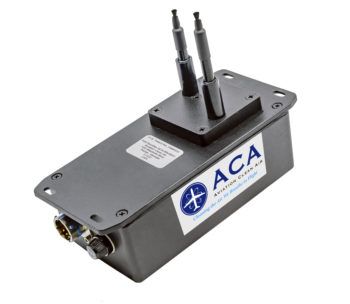
existing ECS
Ionisation is a naturally occurring process, and Aviation Clean Air (ACA) believes replicating and even accelerating it ensures the best indoor air quality. The company’s aviation air purification system is powered by patented NeedlePoint Bi-Polar Ionization (NPBI) technology. The system is installed in an aircraft’s existing environmental control system (ECS) and functions automatically whenever the ECS is running. It creates positive and negative ions electronically from the hydrogen and oxygen molecules in the water vapour present in the air.
“The process effectively cleans and disinfects the interior of a large-cabin aircraft in minutes,” says Howard Hackney, ACA managing member. “By replicating nature’s process electronically, passengers and crew are constantly protected from viruses, germs, organic gases and airborne particulates. The system also greatly reduces the static electricity normally generated on board aircraft, and passengers and crew report feeling refreshed even after long flights.”
Over the years the ACA system has been awarded many STCs and installed on a variety of aircraft. Originally, most customers installed the system for enhanced air quality, with constant purification and elimination of odours and volatile organic compounds (VOCs). With the onset of COVID-19 in 2020, the need to mitigate the spread of that virus and other pathogens increased interest in the system.
Since ACA’s inception, extensive laboratory testing has been ongoing to demonstrate the efficacy of ACA products against a wide variety of known viruses and pathogens, including COVID-19 and its variants. The company also continues to test as new pathogens – such as Mpox and others – are identified. “Based on the successful neutralisation of these and a wide range of other pathogens already tested, ACA is confident the system will be equally as effective on future threats,” says Hackney. “In addition to viruses and pathogens, other threats to cabin air include bacteria, mould, VOCs, various odours and fumes. With ACA installed on board, passengers and crew can feel at ease knowing their aircraft interior is always clean and safe.”
…..
Temperature control

ITT Aerospace Controls designs air duct heaters and aircraft de-icing systems that prioritise comfort and safety for passengers and crew, as well as a compact form and low cost. They provide supplemental heat for the passenger cabin, galley, crew rest and cargo bay areas.
The air duct and fan heater components target specific areas of the aircraft with heated airflow and ensure localised temperature control throughout the cabin. The company shares that the solutions are suitable for all applications and heating requirements on aircraft-standard parts and/or in special configurations. The heaters are also used for aircraft windscreen de-misting during extreme weather conditions.
Made of etched foil embedded in aluminium or composite materials, the compact heater weighs under 4 lbs (1.8kg) with a wattage rating of 50W to 6,000W. These units are offered in a wide range of heat outputs that can be adjusted based on aircraft interior environmental conditions.
In addition, with the aim of keeping passengers and crew safe, ITT also offers a line of electric de-ice and anti-ice systems for turboprop, commercial and business jets. Utilising heaters and dielectrics, these products can be customised to customer specifications. Example applications of the technology include wing and tail ice protection, propeller de-icing, and ram air inlet and engine inlet anti-icing.
For customers that need custom solutions or individual de-icing or freeze protection components, ITT engineers can adapt components to specific complex application requirements. All designs utilise resistance wires or etched foils for the heater elements. Specific anti-freeze technologies are used for a wide range of heaters – from valve, tank, wrap and in-line heaters to duct and external aircraft heaters. These solutions can also be used on aircraft water and waste systems, including drain masts.
ITT has been providing temperature control technology to the aerospace market for more than 40 years. The company’s ECS components are used in commercial, business and general aviation, as well as in military aircraft.
This feature was first published in the September/October 2023 edition of Business Jet Interiors International.


